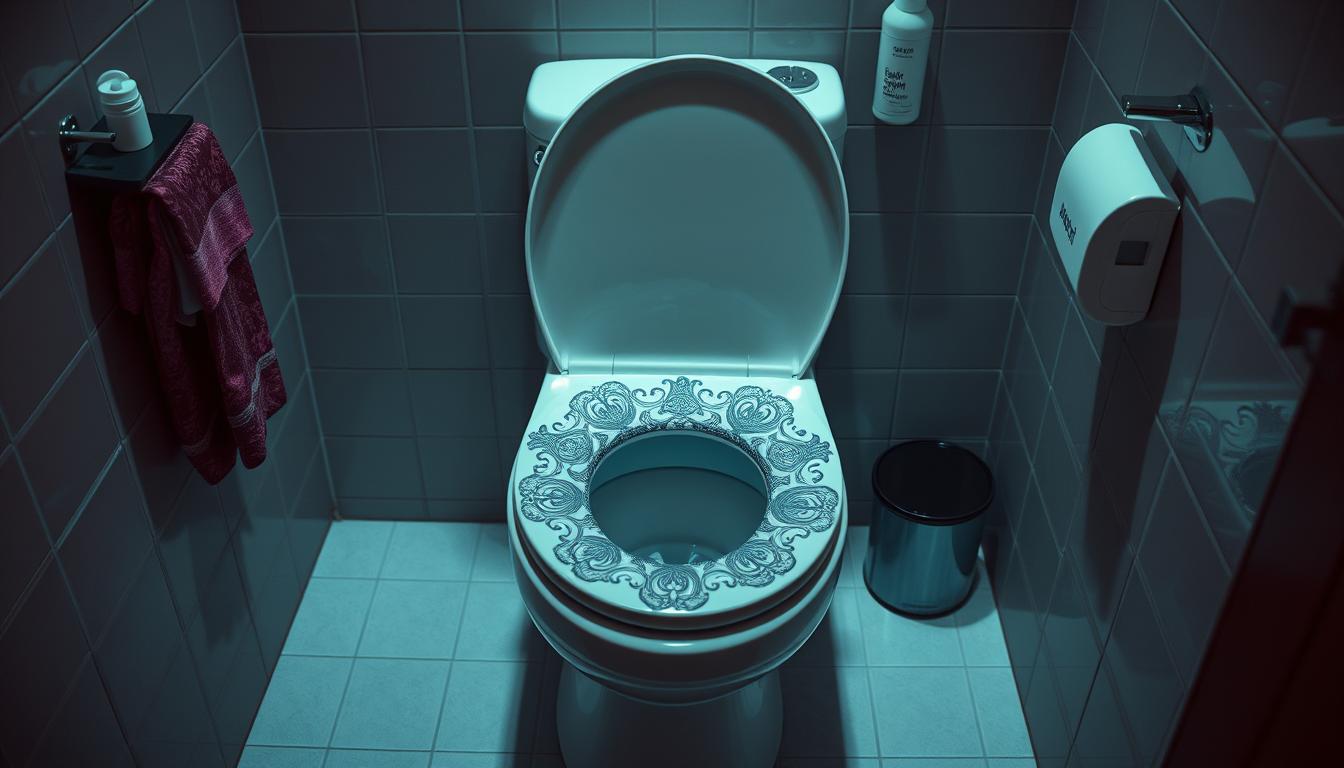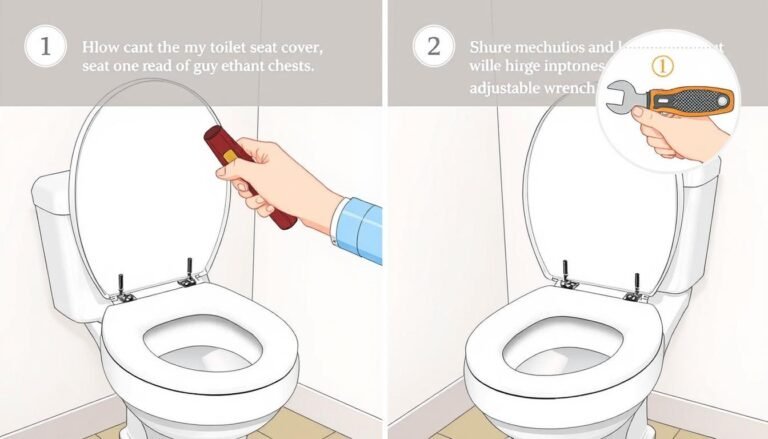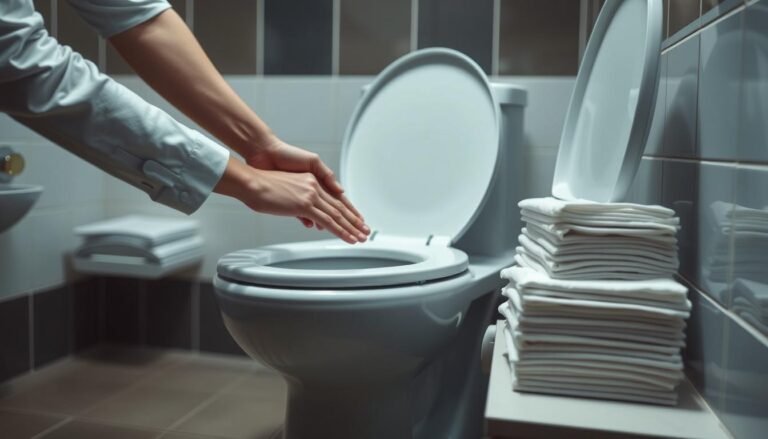Do Toilet Seat Covers Work? Effectiveness Explained.
Many people wonder: do toilet seat covers work? They want to stop bacteria and viruses in public restrooms. But, the effectiveness of paper toilet seat covers is up for debate.
Studies show that paper covers don’t block microbes well. Kleenex and other brands make these covers, but microbes are too small. Aerosolized germs from flushing are a bigger risk. When you flush, germs can fly up to six feet away.
Toilet seat covers might make us feel better, but they’re not that effective. Most germs on toilet seats are harmless skin bacteria, says Dr. William Schaffner from Vanderbilt University Medical Center. So, focusing on washing hands well is more important than worrying about seat covers.
The Concept Behind Toilet Seat Covers
Toilet seat covers are often seen in public bathrooms. They aim to make people feel safer from germs and dirt. While some wonder if public toilet seat covers are safe, opinions on their real benefit vary.
Role in Public Restrooms
In public restrooms, toilet seat covers act as a barrier. This barrier should reduce the risk of spreading germs. But, the covers are not fully protective. Microbes can still pass through them, says David Gimeno Ruiz de Porras, PhD. Hospeco is working to improve seat cover dispensers.
Psychological Security
Using a toilet seat cover can ease your mind in a public restroom. It lessens the worry of touching the toilet directly. Even though catching an illness this way is rare, the thought of it bothers many people.
Surprisingly, studies in 2020 showed toilets are less bacteria-ridden than phones. Still, the fear of getting sick from them persists from old beliefs. Despite lacking evidence, the question of are public toilet seat covers safe lives on. They clearly offer mental comfort to many.
How Toilet Seat Covers are Supposed to Work
Toilet seat covers act as a shield between you and the toilet seat. They are supposed to keep you safe from germs that might be on the seat. But do they really work in keeping the seat’s surface clean?
Barrier Against Germs
Toilet seat covers are meant to stop germs from reaching your skin. This is really important in public bathrooms where germs are more common. For example, research shows that public toilets can have lots of germs in the air because of flushing.
Surface Protection
People wonder if toilet seat covers are hygienic. Paper ones might not fully protect because they can tear or move around. The Hospeco Evogen No-Touch dispenser solves this problem by keeping covers clean before use.
There are also new types of covers made from a special film. They are much better at stopping germs because they don’t let moisture through. Covers that are wrapped one by one also help by keeping them clean until they’re used.
Do Toilet Seat Covers Work: Examining Their Effectiveness
Many people often wonder if disposable toilet seat covers in public restrooms protect against germs. Questions like do disposable toilet seat covers work and how effective are toilet seat covers are common.
Toilet seat covers aim to create a sanitary barrier. This minimizes contact with germs on the toilet seat. However, they might tear or shift, possibly exposing users to germs. Research into their effectiveness has given mixed results.
Some scientists found STDs don’t survive long on toilet seats, making transmission unlikely. Abigail Salyers, PhD, says there’s no proof of diseases spread via toilet seats. Yet, other studies show hospital seats could have MRSA. Cleaning seats with alcohol wipes seems to remove the risk.
Despite ongoing debates, toilet seat covers might still provide hygiene and comfort. Remember they shouldn’t be flushed, to avoid clogs. Always throw them in the trash.
While helpful, toilet seat covers are just a small part of restroom hygiene. They should be used alongside other cleaning practices.
| Aspect | Details |
|---|---|
| Cost | About a penny each |
| Materials | Often made from biodegradable materials |
| Environmental Impact | Reduces impact on landfills but not flushable |
| Invented | In Los Angeles in the 1930s |
| Primary Manufacturer | James River Corp., also known for Dixie cups and Brawny paper towels |
| Usage Region | Approximately half sold in Southern California |
Studies on Germs and Toilet Seat Covers
Recent toilet seat cover research looks into how well they work. Even though many people use them, they might not stop germs as hoped on toilet seats vs toilet seat covers.
Paper Pores and Bacteria
Studies show paper toilet seat covers have big pores. These pores let bacteria and viruses through. Since 2020, over 20 studies worldwide found unsanitary results. They found germs in the air of public toilets.
When you flush, germs can spray up to 1.5 meters like a sneeze. These germs can land on toilet seat covers too. So, while covers aim to protect us, they might not block all germs.
Transmission Risks
The germs on toilet seats vs toilet seat covers debate also looks at how germs spread in bathrooms. Flushing toilets can send germs flying. Hospeco is trying to make better dispensers to keep germs from spreading.
But, it’s unclear if paper covers really keep germs away. New options like ecopolymer film or single-use covers are better. They help stop germs from getting on the covers before we use them.
Common Misconceptions About Toilet Seat Covers
Many think toilet seats are a big source of diseases, leading to the use of toilet seat covers in public restrooms. But public health experts say this isn’t true. The CDC tells us washing hands with soap and water does a better job at keeping us safe.
Another myth is that *toilet seat covers prevent disease*. But the real hot spots for germs are door knobs, faucet handles, and flush levers. These are touched by hands much more often than toilet seats.
A big misunderstanding is that toilet seat covers can stop sexually transmitted infections (STIs). Research shows STIs need direct contact to spread, not just surface contact. This means getting such infections from a toilet seat is highly unlikely.
The impact of toilet seat covers on the environment is also worrisome. Often, they can’t be recycled and hurt the environment. Yet, there are eco-friendly options like Neat Sheets by Butt Buddy, made from biodegradable paper.
| Hygiene Aspect | Common Belief | Scientific Fact |
|---|---|---|
| Toilet Seats | Major source of germs | Not the germiest part; faucets and doorknobs have more bacteria |
| Infection Risk | High risk from sitting on toilet seats | Almost no risk of contracting infections from toilet seats |
| Sexually Transmitted Infections | Can be contracted from toilet seats | Require physical contact, not possible through toilet seats |
| Environmental Impact | Toilet seat covers are harmless | Non-recyclable and harmful to the environment |
So, when you wonder *are toilet seat covers necessary for hygiene*, remember the risk from toilet seats is low. Good hygiene comes from washing hands well, not from using seat covers. Knowing the *common misconceptions about toilet seat covers* can help you choose wisely in public restrooms.
The Hygiene Benefits of Using Toilet Seat Covers
Toilet seat covers are essential for keeping clean in public restrooms. They act as a barrier from germs on unsanitary surfaces.
Reducing Direct Contact
Reducing direct contact with the toilet seat is a key benefit. It lowers the risk of getting germs like Salmonella. Disposable seat covers make this easy and hygienic.
For those who prefer reusable options, fabric seat covers are available. Luxury restrooms sometimes have automatic plastic covers that change by themselves, keeping things fresh.
Minimizing Perceived Risk
Using seat covers can make people feel safer in public restrooms. It gives them comfort by lowering the fear of germs.
These covers not only keep things clean but also lower worry about germs spreading. There are many types, from paper to advanced films, to fit everyone’s needs.
Toilet seat covers are important for clean, worry-free restroom use. They help users avoid germs and feel more comfortable.
Richmond Advantage has been a reliable supplier of toilet seat covers since 1986. They offer covers in various materials, like recycled paper. These covers help make restrooms cleaner and safer.
| Type of Cover | Material | Usage | Pros |
|---|---|---|---|
| Disposable Paper | Biodegradable Paper | Single-Use | Easy to Use, Hygienic |
| Reusable Fabric | Cloth | Personal Use | Eco-Friendly, Sustainable |
| Automatic Plastic | Plastic Film | Luxury Restrooms | Sanitary, Convenient |
Limitations of Paper Toilet Seat Covers
Since 2020, more than 20 international studies have found unclean conditions in public restrooms. A big problem with paper toilet seat covers is what they’re made of. Because they are paper, moisture can easily break them down. This makes them less effective at keeping germs away.
Studies show that toilet flushing spreads germs throughout the restroom, even onto the covers’ dispensers. This makes people wonder: are toilet seat liners sanitary enough for public use? Paper covers might also move or rip, making them even less protective against germs.
Additionally, paper toilet seat covers have another issue. Their pores are too big to stop bacteria and viruses. Research shows they might not stop germs from reaching the user. This raises concerns when discussing toilet seat cover effectiveness. Traditional paper might not be as clean as expected.
Despite these issues, there are better options available. New seat covers made from ecopolymer film are better barriers against germs. They dissolve in water and block microorganisms. Plus, covers wrapped on their own are safer. They are less likely to get germs from toilet flushes.
In light of these discoveries, Hospeco is stepping up. They’ve made new dispensers, like the Evogen No-Touch, to up hygiene levels. They aim to overcome the old paper cover issues and safeguard restroom users better.
New Innovations in Toilet Seat Cover Designs
The quest for better hygiene in public restrooms has sparked exciting innovations in toilet seat cover designs. These new ideas are tackling the issues of traditional paper covers. They use modern materials and features.
Advanced Ecopolymer Film
One standout innovation is the use of advanced ecopolymer film. This is a big change from paper covers. Paper ones might actually make germ exposure worse.
This new material forms a strong barrier against germs and is flush-friendly. It helps fight against germs effectively.
Individually Wrapped Covers
Individually wrapped covers are raising hygiene standards. They stop germs from spreading before the cover is even used. This happens because they block germs from flush-plumes.
Hospeco, a leading name, made changes to offer these new covers. They introduced the Evogen No-Touch toilet seat cover dispenser. It makes restrooms cleaner.
With a focus on hygiene, these innovations in toilet seat covers are making public spaces safer. Hospeco is leading the way in improving restroom hygiene, especially after COVID-19.
Alternative Hygiene Practices in Public Restrooms
Toilet seat covers help, but alternative hygiene practices make public restrooms safer. Practices like hand washing and UVC device usage lower pathogen risks.
Hand Washing
Good hand washing stops germs from spreading. The CDC says washing for 20 seconds with soap and warm water removes pathogens. Since flu viruses can live on surfaces for 48 hours, cleaning hands is key.
E. coli and Staphylococcus are often found in restrooms. San Diego State University found a lot of staph bacteria there. Drying hands with paper towels is better than air dryers to avoid spreading germs.
Use hand sanitizer with 60% alcohol if soap isn’t available. It’s a good backup for keeping clean. Keeping hands clean is crucial for stopping infectious diseases.
Use of UVC Devices
UVC devices are being used more in restrooms. They use UV light to kill germs on surfaces and in the air. This method is great for stopping the spread of germs like SARS-CoV-2 and MRSA.
A 2020 Travel Medicine and Infectious Disease study found phones carry many germs. UVC devices help keep restrooms clean by reducing these germs. They show the need for new tech in fighting health threats.
Using these alternative hygiene practices keeps restrooms clean and safe. It helps improve public health. Hand washing and UVC technology lower infection risks and improve cleanliness.
Should You Rely on Toilet Seat Covers for Protection?
Is it enough to use toilet seat covers in public restrooms for protection? Even though many people use them, there’s still debate about their trustworthiness. The big question is, do these covers stop germs like Salmonella and E. coli?
Research shows that covers might not be as protective as we think. For example, Trichomonas vaginalis can stay alive for hours outside the body. This means covers might not be the barrier we hope for. Plus, a study from 2020 found toilet seats have less bacteria than smartphones.
The thing is, toilet seat covers are made of porous paper. Because of this, germs can pass through and touch your skin. So, people are right to wonder, do toilet seat protectors work?
That said, getting sick from a well-kept public toilet seat is rare. Still, over a fourth of women would rather squat if there are no covers. This offers a kind of mental comfort for them.
Looking at how we protect ourselves from germs in restrooms is key:
| Hygiene Practice | Effectiveness Against Germs |
|---|---|
| Hand Washing | Highly Effective |
| Using UVC Devices | Highly Effective |
| Toilet Seat Covers | Limited Protection |
It’s smarter to focus on good hygiene, like washing hands a lot, instead of just using toilet seat covers. This protects us more from germs and keeps us healthier in public restrooms.
Comprehensive Hygiene Strategies for Public Restrooms
Keeping public restrooms clean means having comprehensive hygiene strategies. This includes setting up no-touch tools like automatic soap dispensers and touchless faucets. Such steps help lessen the spread of germs through surface touch. Good air flow also plays a big role in taking away airborne germs, which keeps us safer.
Research shows public restrooms can spread germs through the air when toilets flush. Flushing can send germs flying up to 1.5 meters away quickly. That’s why it’s smart to use water-soluble ecopolymer film seat covers and wrapped covers. These new covers are better at staying clean than old-style paper ones.
It helps a lot if people close the toilet lid before flushing to keep germs from flying. Washing hands well and using hand sanitizer with 60% alcohol are key steps too. The CDC tells us washing hands right could cut deaths from diarrhea diseases by half. That’s why choosing automatic, touch-free fixtures makes bathrooms more user-friendly and clean.
UVC devices can kill germs on surfaces and in the air, making restrooms safer. Frequent cleaning, surface disinfection, and good trash management are all part of the plan. Focusing on all cleanliness areas makes public restrooms better and healthier for everyone.

Hey there, I’m Alex Hanson and I’m passionate about all things covers! Whether you’re looking for a car seat cover to protect your vehicle or an oven cover to keep your kitchen clean, I’m here to help. With years of experience in the industry, I have plenty of knowledge and insights to share with my readers. So, if you care about protecting your belongings and making them look their best, you’re encouraged to read my blog as I explore the perfect cover for every need.



